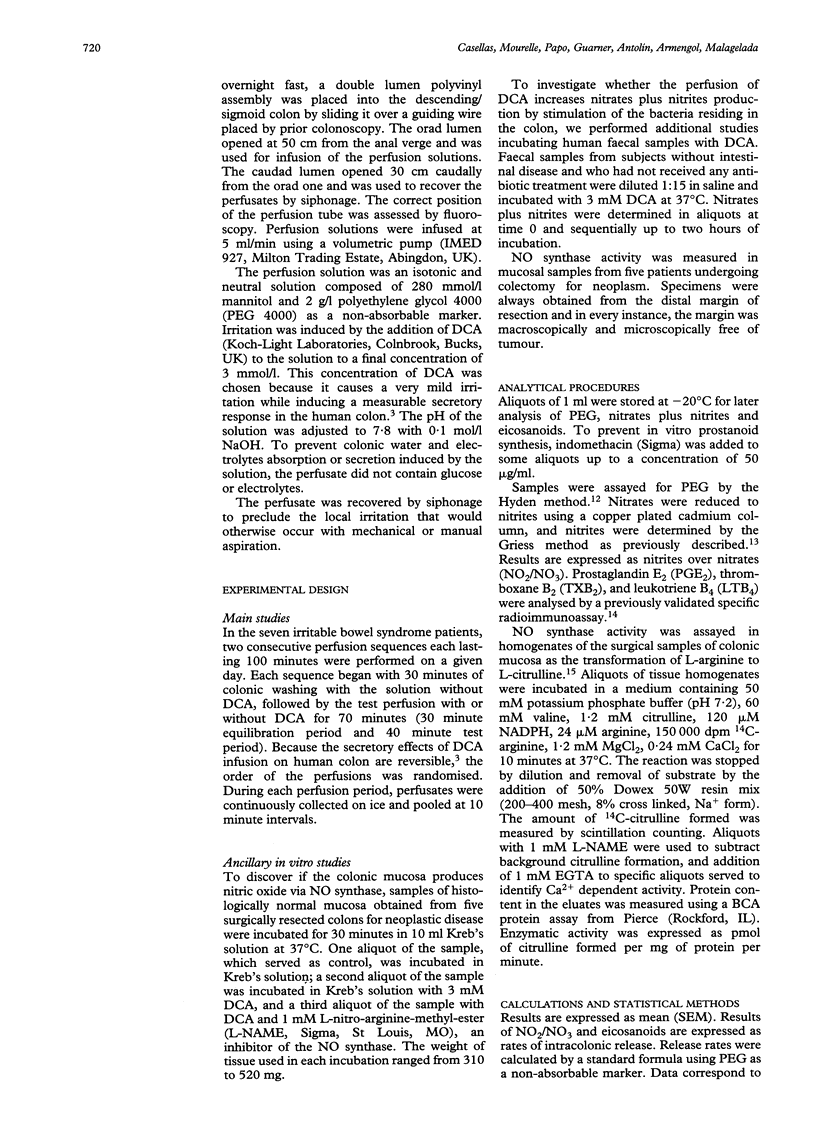Abstract
AIM--To measure the intracolonic release of nitric oxide end products (nitrates plus nitrites) and eicosanoids in response to intraluminal irritation with deoxycholic acid (DCA). PATIENTS--Seven patients with irritable bowel syndrome. METHODS--The left colon was perfused with a solution with or without 3 mM deoxycholic acid. Aspirates were assayed for eicosanoids by specific radioimmuno-assay, and for nitrates plus nitrites by the Griess reaction. To confirm that stimulated colonic mucosa can produce nitric oxide (NO), ancillary studies were performed in vitro using samples of normal mucosa obtained from five surgically resected colons. Samples were incubated for 30 minutes in Kreb's solution, 3 mM DCA or DCA with 1 mM L-nitro-arginine-methyl-ester (L-NAME) to inhibit the NO synthase. Finally, NO synthase activity was measured in five samples of human colonic mucosa. RESULTS--Intracolonic release of nitrates plus nitrites was basally undetectable in six of seven patients. Bile acid considerably increased the release of prostaglandin E2 and nitrates plus nitrites (p < 0.01). By contrast, no increase in thromboxane and leukotriene was seen. In vitro mucosal incubation with DCA increased the production of NO synthase products, which was blocked by L-NAME. Activity of Ca+2 independent NO synthase was detectable in four of five samples of human colonic mucosa. CONCLUSION--The human colonic mucosa responds to bile acid induced irritation by a surge in NO generation via NO synthase.
Full text
PDF




Selected References
These references are in PubMed. This may not be the complete list of references from this article.
- Argenzio R. A., Henrikson C. K., Liacos J. A. Effect of prostaglandin inhibitors on bile salt-induced mucosal damage of porcine colon. Gastroenterology. 1989 Jan;96(1):95–109. doi: 10.1016/S0016-5085(89)80008-3. [DOI] [PMC free article] [PubMed] [Google Scholar]
- Beckman J. S., Beckman T. W., Chen J., Marshall P. A., Freeman B. A. Apparent hydroxyl radical production by peroxynitrite: implications for endothelial injury from nitric oxide and superoxide. Proc Natl Acad Sci U S A. 1990 Feb;87(4):1620–1624. doi: 10.1073/pnas.87.4.1620. [DOI] [PMC free article] [PubMed] [Google Scholar]
- Boughton-Smith N. K., Hutcheson I. R., Deakin A. M., Whittle B. J., Moncada S. Protective effect of S-nitroso-N-acetyl-penicillamine in endotoxin-induced acute intestinal damage in the rat. Eur J Pharmacol. 1990 Dec 4;191(3):485–488. doi: 10.1016/0014-2999(90)94185-z. [DOI] [PubMed] [Google Scholar]
- Craven P. A., Pfanstiel J., DeRubertis F. R. Role of reactive oxygen in bile salt stimulation of colonic epithelial proliferation. J Clin Invest. 1986 Mar;77(3):850–859. doi: 10.1172/JCI112382. [DOI] [PMC free article] [PubMed] [Google Scholar]
- Erickson R. A., Chang K., Lifrak E., Rivera N., Stachura J. 16,16-Dimethyl prostaglandin E2 reduces bile acid-mediated intestinal vascular injury in rats. Gastroenterology. 1992 Apr;102(4 Pt 1):1295–1305. [PubMed] [Google Scholar]
- Guarner C., Soriano G., Tomas A., Bulbena O., Novella M. T., Balanzo J., Vilardell F., Mourelle M., Moncada S. Increased serum nitrite and nitrate levels in patients with cirrhosis: relationship to endotoxemia. Hepatology. 1993 Nov;18(5):1139–1143. [PubMed] [Google Scholar]
- Hata Y., Ota S., Nagata T., Uehara Y., Terano A., Sugimoto T. Primary colonic epithelial cell culture of the rabbit producing prostaglandins. Prostaglandins. 1993 Feb;45(2):129–141. doi: 10.1016/0090-6980(93)90028-6. [DOI] [PubMed] [Google Scholar]
- Hibbs J. B., Jr, Taintor R. R., Vavrin Z., Rachlin E. M. Nitric oxide: a cytotoxic activated macrophage effector molecule. Biochem Biophys Res Commun. 1988 Nov 30;157(1):87–94. doi: 10.1016/s0006-291x(88)80015-9. [DOI] [PubMed] [Google Scholar]
- Krag E., Phillips S. F. Effect of free and conjugated bile acids on net water, electrolyte, and glucose movement in the perfused human ileum. J Lab Clin Med. 1974 Jun;83(6):947–956. [PubMed] [Google Scholar]
- Lowenstein C. J., Dinerman J. L., Snyder S. H. Nitric oxide: a physiologic messenger. Ann Intern Med. 1994 Feb 1;120(3):227–237. doi: 10.7326/0003-4819-120-3-199402010-00009. [DOI] [PubMed] [Google Scholar]
- McCall T. B., Boughton-Smith N. K., Palmer R. M., Whittle B. J., Moncada S. Synthesis of nitric oxide from L-arginine by neutrophils. Release and interaction with superoxide anion. Biochem J. 1989 Jul 1;261(1):293–296. doi: 10.1042/bj2610293. [DOI] [PMC free article] [PubMed] [Google Scholar]
- Moncada S. The 1991 Ulf von Euler Lecture. The L-arginine: nitric oxide pathway. Acta Physiol Scand. 1992 Jul;145(3):201–227. doi: 10.1111/j.1748-1716.1992.tb09359.x. [DOI] [PubMed] [Google Scholar]
- Mourelle M., Guarner F., Moncada S., Malagelada J. R. The arginine/nitric oxide pathway modulates sphincter of Oddi motor activity in guinea pigs and rabbits. Gastroenterology. 1993 Nov;105(5):1299–1305. doi: 10.1016/0016-5085(93)90132-v. [DOI] [PubMed] [Google Scholar]
- Rampton D. S., Breuer N. F., Vaja S. G., Sladen G. E., Dowling R. H. Role of prostaglandins in bile salt-induced changes in rat colonic structure and function. Clin Sci (Lond) 1981 Nov;61(5):641–648. doi: 10.1042/cs0610641. [DOI] [PubMed] [Google Scholar]
- Smith P. L., Montzka D. P., McCafferty G. P., Wasserman M. A., Fondacaro J. D. Effect of sulfidopeptide leukotrienes D4 and E4 on ileal ion transport in vitro in the rat and rabbit. Am J Physiol. 1988 Aug;255(2 Pt 1):G175–G183. doi: 10.1152/ajpgi.1988.255.2.G175. [DOI] [PubMed] [Google Scholar]
- Southorn P. A., Powis G. Free radicals in medicine. I. Chemical nature and biologic reactions. Mayo Clin Proc. 1988 Apr;63(4):381–389. doi: 10.1016/s0025-6196(12)64861-7. [DOI] [PubMed] [Google Scholar]
- Zhao D., Hirst B. H. Prostaglandin protects against bile salt induced increases in proton permeation of duodenal brush border membrane. Gut. 1991 Jun;32(6):645–648. doi: 10.1136/gut.32.6.645. [DOI] [PMC free article] [PubMed] [Google Scholar]


